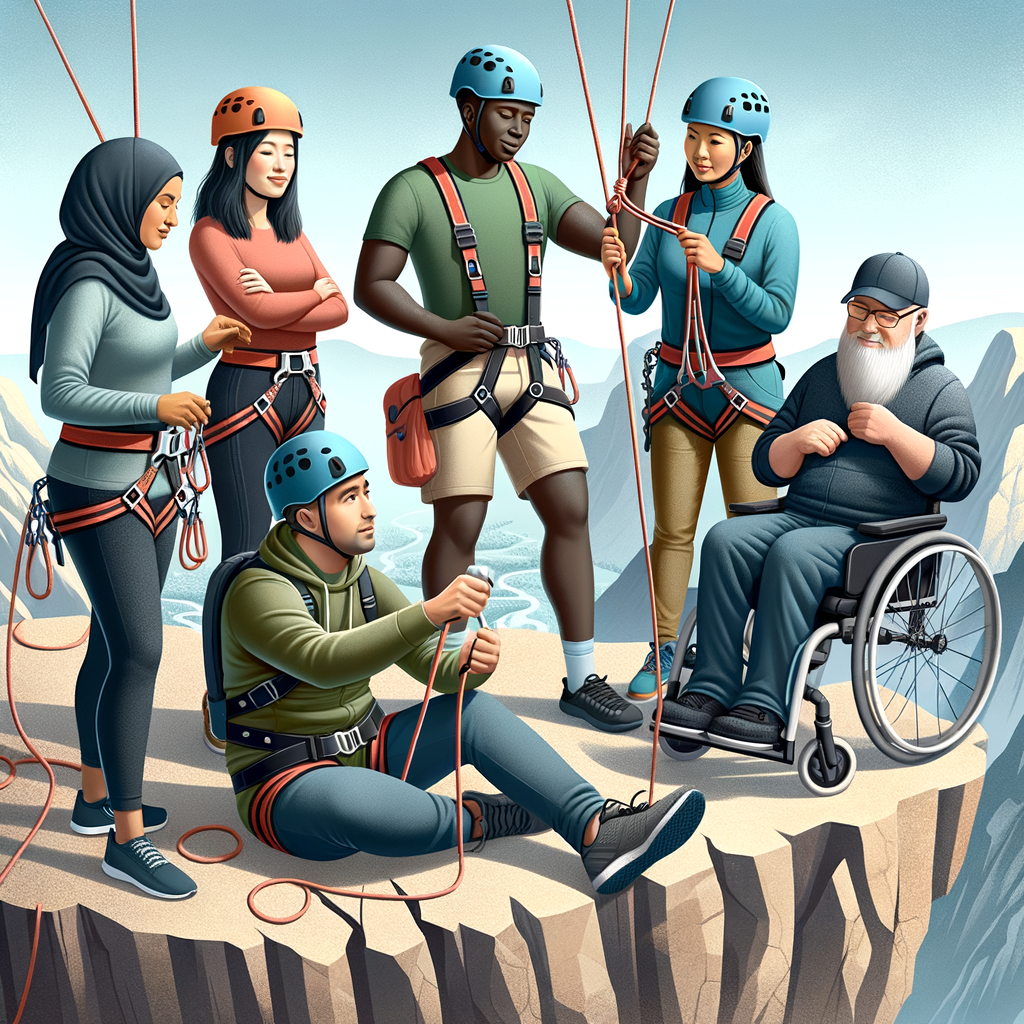
Introduction to Adaptive Rappelling
Adaptive rappelling is an exciting outdoor activity that everyone can enjoy, regardless of their physical abilities. It’s a technique that has been specially designed to accommodate people with diverse abilities. This inclusive approach to rappelling ensures that everyone can experience the thrill and challenge of this outdoor sport.
- Understanding the concept of Adaptive Rappelling
- Benefits of Adaptive Rappelling for Diverse Abilities
Adaptive rappelling is a modified form of the traditional rappelling technique. It involves the use of specialized equipment and methods to make the activity accessible to people with various physical abilities. Whether you have a mobility impairment, visual impairment, or any other physical challenge, adaptive rappelling can be tailored to meet your specific needs.
Adaptive rappelling offers numerous benefits. Firstly, it provides an opportunity for everyone to participate in an exciting outdoor activity, promoting inclusivity. Secondly, it can help improve physical strength, coordination, and balance. Lastly, it can boost self-confidence and provide a sense of achievement.
Adaptive rappelling is more than just an outdoor activity. It’s a testament to the human spirit’s resilience and adaptability. It’s about breaking down barriers and proving that with the right adaptations, everyone can enjoy the thrill of rappelling.
Let’s delve deeper into the techniques, methods, and benefits of adaptive rappelling in the following sections.
Adaptive Rappelling Techniques
Adaptive rappelling techniques are designed to ensure everyone, regardless of their physical abilities, can enjoy the thrill of descending a rock face. Let’s delve into the basic techniques that form the foundation of adaptive rappelling.
Basic Techniques
Two fundamental aspects of adaptive rappelling are proper gear selection and correct body positioning. These elements are crucial to ensuring safety and efficiency during the activity.
- Proper Gear Selection
Choosing the right gear is the first step in adaptive rappelling. The equipment should be tailored to the individual’s needs and abilities. For instance, a person with limited lower body strength might need a full-body harness for additional support.
Here’s a basic list of gear needed for adaptive rappelling:
| Gear | Description |
|---|---|
| Helmet | Protects the head from falling debris and impacts. |
| Harness | Secures the person to the rope and provides support. |
| Rappelling Rope | Used for descent, it should be strong and durable. |
| Gloves | Protects the hands from rope burn and provides a better grip. |
- Correct Body Positioning
Proper body positioning is vital in adaptive rappelling. It helps maintain balance, control the speed of descent, and prevent injuries. The ideal body position involves leaning back into the harness and keeping the legs slightly bent. This posture allows for a controlled and smooth descent.
Remember, the key to successful adaptive rappelling is to practice these basic techniques until they become second nature. This will not only enhance your rappelling experience but also ensure your safety during the activity.
Advanced Techniques
Now that we’ve covered the basics, let’s dive into some advanced techniques. These methods will help you to overcome obstacles and adapt to different terrains. Remember, practice makes perfect. So, don’t be discouraged if you don’t get it right the first time. Let’s get started!
- Overcoming Obstacles
- Adapting to Different Terrains
Obstacles can come in many forms when you’re rappelling. It could be a large rock, a steep slope, or even a tree. The key to overcoming these obstacles is to stay calm, think clearly, and use your training.
For example, if you encounter a large rock, you can use a technique called ‘chimneying’. This involves placing your back against one side of the rock and your feet against the other, then slowly shimmying up or down the rock. It’s a challenging technique, but with practice, you can master it.
Remember, safety is always the priority. So, if an obstacle seems too dangerous to overcome, it’s better to find another way around.
Every terrain presents its own unique challenges. For instance, a sandy terrain can be slippery and unstable, while a rocky terrain can be sharp and uneven. The key to adapting to different terrains is to understand their characteristics and adjust your techniques accordingly.
For example, on a sandy terrain, you might need to dig your heels in to get a good grip. On a rocky terrain, you might need to use your hands and feet to navigate the uneven surface.
It’s also important to have the right gear for the terrain. For instance, you might need special shoes for a sandy terrain, or gloves for a rocky terrain. Always do your research and prepare in advance.
In conclusion, advanced rappelling techniques require practice, patience, and preparation. But with time and effort, you can overcome any obstacle and adapt to any terrain. Happy rappelling!
Inclusive Rappelling Methods
Everyone should have the opportunity to experience the thrill and challenge of rappelling. With the right methods and adaptations, rappelling can be an inclusive activity for all, regardless of their abilities. Let’s explore how we can adapt rappelling for everyone.
Adapting Rappelling for All Abilities
Adapting rappelling for all abilities involves modifying equipment and adopting adaptive climbing techniques. These adaptations ensure that everyone, regardless of their abilities, can participate in and enjoy rappelling.
- Modifying Equipment for Different Abilities
- Adaptive Climbing Techniques
Modifying rappelling equipment is a crucial step in making the sport accessible to all. This could involve using specialized harnesses, adaptive rappelling devices, or other equipment designed to accommodate different physical abilities. For example, a person with limited hand strength might use a device with an easy-to-grip handle. These modifications ensure that everyone can safely and effectively participate in rappelling.
Adaptive climbing techniques are another key aspect of inclusive rappelling. These techniques might involve different body positioning, using additional equipment, or employing alternative methods to navigate the rappelling route. For instance, a person with a lower limb disability might use a technique that emphasizes upper body strength. By learning and applying these techniques, individuals of all abilities can enjoy the thrill of rappelling.
By modifying equipment and adopting adaptive climbing techniques, we can make rappelling an inclusive activity for all. Everyone, regardless of their abilities, should have the opportunity to experience the thrill and challenge of this sport. With the right adaptations, we can make this a reality.
Rappelling Techniques for Disabilities
Adaptive rappelling is a powerful tool that allows everyone, regardless of their physical or visual abilities, to experience the thrill and challenge of descending a cliff or rock face. Let’s explore some of the techniques that make this possible.
- Adaptive Techniques for Visual Impairments
- Adaptive Techniques for Physical Disabilities
For those with visual impairments, rappelling can still be an exhilarating and rewarding experience. The key is to adapt the techniques and equipment used. Tactile markers can be added to ropes and gear to help individuals identify different pieces of equipment. Verbal communication from a sighted guide can also be crucial, providing step-by-step instructions and feedback.
One example of this in action is the case of John, a visually impaired individual who successfully rappelled down a 50-foot cliff. With the help of tactile markers on his gear and continuous verbal guidance from his instructor, John was able to safely and confidently descend the cliff.
Physical disabilities can range from mobility impairments to limb differences, but that doesn’t mean rappelling is out of reach. Adaptive equipment such as modified harnesses and pulley systems can be used to accommodate different physical abilities.
Consider the story of Sarah, a woman with a mobility impairment. Using a specially designed harness and the assistance of her instructor, she was able to rappel down a 100-foot rock face. This was a feat she never thought possible, but with the right adaptive techniques, she was able to conquer the cliff and her fears.
In conclusion, adaptive rappelling techniques open up a world of possibilities for individuals with disabilities. With the right equipment and guidance, anyone can experience the thrill of rappelling.
Accessible Rappelling
Accessible rappelling is a form of outdoor activity that is designed to be inclusive for everyone, regardless of their physical abilities or limitations. It’s all about making the thrilling sport of rappelling available to all, ensuring that everyone has the opportunity to experience the excitement and challenge it offers.
Creating Accessible Rappelling Environments
Creating an accessible rappelling environment involves careful planning and consideration. The two main aspects to focus on are choosing accessible locations and ensuring safety and comfort. Let’s delve into these aspects in detail.
- Choosing Accessible Locations
Not all rappelling locations are created equal. Some are more accessible than others. When choosing a location, consider factors such as ease of access, terrain, and proximity to medical facilities. Locations with smooth, even terrain and close to medical facilities are ideal. It’s also important to consider the availability of necessary facilities like restrooms and parking. Remember, the goal is to create an environment where everyone can participate and enjoy.
- Ensuring Safety and Comfort
Safety is paramount in any outdoor activity, and rappelling is no exception. All participants should be equipped with the necessary safety gear, including helmets, harnesses, and gloves. Regular safety checks and maintenance of equipment are also crucial. Comfort is equally important. Participants should feel comfortable with the height and difficulty level of the rappel. It’s always a good idea to have experienced guides on hand to provide assistance and reassurance.
By focusing on these two aspects, we can create a rappelling environment that is not only accessible but also safe and enjoyable for everyone.
| Key Aspects | Considerations |
|---|---|
| Location | Access, Terrain, Proximity to medical facilities, Facilities availability |
| Safety and Comfort | Safety gear, Regular checks, Comfort level, Experienced guides |
In conclusion, accessible rappelling is about more than just making the sport available to everyone. It’s about creating an environment where everyone can participate, feel safe, and most importantly, have fun. So, let’s embrace accessible rappelling and make the outdoors truly inclusive for all.
Inclusive Outdoor Activities
Outdoor activities are a great way to enjoy nature and stay fit. However, for individuals with disabilities, participating in these activities can be challenging. Thankfully, there are adaptive sports that are inclusive and accessible to everyone, regardless of their physical abilities. Let’s explore some of these adaptive outdoor sports.
Other Adaptive Outdoor Sports
Adaptive sports are modified versions of traditional sports, designed to accommodate individuals with disabilities. These sports provide an equal opportunity for everyone to participate and enjoy outdoor activities. Here are a couple of examples:
- Adaptive Kayaking
- Adaptive Hiking
Adaptive kayaking is a water sport that has been modified to accommodate individuals with disabilities. Special equipment such as paddle holders, seat cushions, and outriggers for stability are used to make the sport accessible. It’s a great way to enjoy the water and nature, and it provides a good workout too.
Adaptive hiking is another outdoor activity that has been modified for individuals with disabilities. Specialized hiking equipment like all-terrain wheelchairs and adaptive walking aids are used to help individuals navigate hiking trails. It’s a fantastic way to enjoy the great outdoors and get some exercise at the same time.
These are just a few examples of the many adaptive outdoor sports available. They prove that with the right modifications and equipment, everyone can enjoy the great outdoors. So, whether you’re a thrill-seeker or just looking for a way to stay active, there’s an adaptive sport out there for you.
Rappelling for Everyone: Case Studies
In this section, we will explore some inspiring success stories of individuals who have embraced rappelling as an inclusive outdoor activity. These case studies highlight the transformative power of adaptive rappelling, demonstrating how it can help overcome physical limitations and build confidence.
Success Stories
-
Case Study 1: Overcoming Physical Limitations
Meet John, a 45-year-old man who was born with a congenital limb deficiency. Despite his physical limitations, John never let his condition define him. He was determined to participate in outdoor activities like everyone else.
John discovered adaptive rappelling and it changed his life. With the help of specialized equipment and trained professionals, he was able to experience the thrill of descending a vertical rock face. The activity not only provided him with a sense of freedom but also improved his physical strength and endurance.
“Rappelling has given me a new perspective on life. It’s not about what you can’t do, it’s about what you can,” John shares.
-
Case Study 2: Building Confidence through Rappelling
Next, let’s look at the story of Sarah, a shy 12-year-old girl who struggled with low self-esteem. Her parents introduced her to rappelling in hopes that it would help build her confidence.
With each rappelling session, Sarah’s confidence grew. She learned to trust herself and her abilities. The experience of overcoming her fears and achieving her goals on the rappelling course translated into other areas of her life as well.
“Rappelling has taught me that I’m stronger than I think. It’s helped me believe in myself,” Sarah says.
These case studies show that adaptive rappelling is more than just an outdoor activity. It’s a tool that can help individuals overcome physical limitations, build confidence, and lead a more fulfilling life.
Conclusion: Embracing Adaptive Rappelling
As we conclude, it’s important to reflect on the transformative power of adaptive rappelling. This innovative approach to outdoor sports has opened up new possibilities, breaking down barriers and making the thrill of rappelling accessible to everyone. Let’s take a moment to look ahead and consider the future of adaptive rappelling and the broader push for inclusivity in outdoor sports.
- The Future of Adaptive Rappelling
- Encouraging Inclusivity in Outdoor Sports
Adaptive rappelling is more than just a trend; it’s a movement that’s here to stay. As technology continues to advance, so too will the equipment and techniques used in adaptive rappelling. We can expect to see even more innovative solutions that make this sport safer and more accessible for everyone. But it’s not just about the gear. The future of adaptive rappelling also lies in the hands of the people who embrace it – from the instructors who teach it, to the communities that support it, and the individuals who dare to challenge themselves with it.
Inclusivity in outdoor sports goes beyond adaptive rappelling. It’s about creating an environment where everyone, regardless of their physical abilities, feels welcomed and empowered to participate. This means providing accessible facilities, offering inclusive programs, and fostering a culture of respect and understanding. By doing so, we can help ensure that the benefits of outdoor sports – from the physical health gains to the mental well-being boosts – are enjoyed by all.
As we look to the future, let’s remember the power of adaptive rappelling and the importance of inclusivity in outdoor sports. Let’s continue to challenge the status quo, push boundaries, and create opportunities for everyone to experience the joy and thrill of outdoor sports. Because when it comes to the great outdoors, there should be no limits.













